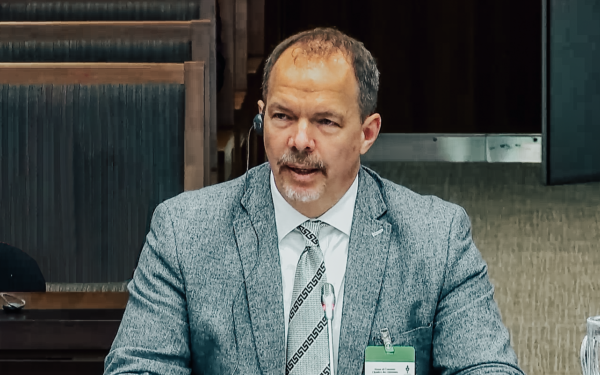CIRA’s president and CEO Byron Holland will join three other experts in a panel discussion on Smart Community strategies at Canadians Connected, CIRA’s upcoming annual general meeting and symposium. We asked these three panellists a few questions about Smart Communities and we look forward to digging in further at the event.
CIRA’s president and CEO Byron Holland will join three other experts in a panel discussion on Smart Community strategies at Canadians Connected, CIRA’s upcoming annual general meeting and symposium. We asked these three panellists a few questions about Smart Communities and we look forward to digging in further at the event. Be sure to register and join us online or in-person in Ottawa on September 19th.
In addition to Byron, the panel will include: Sri Elaprolu (Global Lead & Senior Manager, Public Sector IoT, Amazon Web Services), Jan Harder (Councillor, City of Ottawa), and Dan Mathieson (Mayor, City of Stratford). Learn more about the panel and read their biographies here.
1. Why is it important for cities in Canada to engage in Smart Community strategies?
Sri Elaprolu – Amazon Web Services
Any city that collects data (citizen-supplied, sensor-captured, or open data) and leverages that data to make decisions in or near real-time to provide better services to citizens, improve operations, and lower costs can be deemed a Smart City. For example, a Smart City might lower congestion on its streets and lower pollution by optimizing transportation infrastructure and assets. It might dramatically reduce energy consumption by deploying a range of real-time analysis sensors to optimize the use of lights to provide just in time or incident-based illumination. It might provide faster response to public safety incidents via real-time capture and analysis of sensor and surveillance data. The power to transform city operations and services through the use of Internet of Things (IoT) solutions is only limited by imagination and economics.
Dan Mathieson – City of Stratford, Ontario
It is critically important for cities to embrace changing technology and innovative ways to deliver services to our residents. In many instances cities can share their experiences to improve the quality of life of their residents. Cities can play a leading role in the adoption of new technology, setting the tone for their corporate and residential constituents to operate and exist in a global environment where geography is no longer a limiting factor.
Site selection criteria for new business is multi-faceted. A Smart City increases competitiveness in quality of life, connectivity, and the ability to respond and pivot to the ever-changing needs of business in a global economy.
Jan Harder – City of Ottawa, Ontario
Cities in Canada and around the world are using Smart City strategies to address opportunities and challenges, resulting primarily from urbanization and globalization. These strategies can provide residents with an improved quality of life. For example, Smart City strategies can provide solutions to problems like traffic congestion or public safety. They are also important to ensuring residents and businesses have access to an affordable modern communication infrastructure and participate and indeed compete in today’s digital world.
To remain competitive in the current digital economy, cities must be smart and ensure that their residents and businesses have the infrastructure, policy environment, services and ecosystem to compete. Smart employees want to live in Smart Cities. To attract top talent, we need to be a smart city. Research shows that economic growth is experienced when the significance of scientifically, technologically and artistically creative workers is taken into account. They are key to a city’s ability to be economically competitive and grow its knowledge based economy.
2. Can you give examples of Smart Community initiatives you’ve participated in and what their outcomes have been?
Jan Harder – City of Ottawa, Ontario
I have a few examples here in Ottawa. We’ve begun a citywide energy efficient (LED) street lighting conversion program with an annual investment of $4 million for four years. The anticipated payback period will be just six years and energy savings associated with this program are estimated to reduce electrical consumption by more than 50 per cent or 29,000,000 kWh. As well, salt is a large part of the annual winter road maintenance budget and with the objective of cost-containment, all city-owned salt spreaders are now connected to an automated “Salt Management System” which takes into account a variety of factors such as ambient temperature, road temperature, the weather forecast etc. The spreaders deliver only the required amount of salt, thus saving significantly.
Ottawa will soon launch the first ever autonomous vehicle test track on active city streets, integrating live city services. The test area will be fully equipped with the latest GPS and telecommunications technology, and will be integrated with city traffic system operation and street lighting. Earlier this year, Ontario became the first province to set a regulatory framework to permit testing of self-driving vehicles, an emerging technology where the province is keen to be a leader, Ottawa’s autonomous and connected sector is thriving with mainstay companies like Blackberry QNX and newcomers such as Ford.
Sri Elaprolu – Amazon Web Services
I have a couple of examples – one from the U.S. and another from Indonesia.
Leveraging Amazon Web Services (AWS) infrastructure, the City of Chicago was able to launch OpenGrid, Chicago’s highest profile technology release to date. OpenGrid is a real-time, open source situational awareness program intended to improve the quality of life for citizens and improve the efficiency of city operations. Born out of an internal project called Windy Grid, the City of Chicago expanded the program from emergency response to 311 calls, business licenses, immediate weather concerns, and more. It put the open source code on AWS, allowing the public to interact with the data to see information about the city. With AWS, the City of Chicago has the flexibility and agility to deliver better services to its citizens.
PetaJakarta is an applied research project originally supported by the University of Wollongong’s Global Challenges Program and a Twitter data grant. It brings together mobile mapping and local flood information for the city of Jakarta, Indonesia. The platform lets the 28 million citizens of Jakarta share real-time flood information in a part of the world increasingly affected by flooding. In addition to the collection and dissemination of information by community members through location-enabled mobile devices, researchers can complement existing manual water gauges with water-level-sensing devices to inexpensively increase monitoring across the waterway network in Jakarta.
Dan Mathieson – City of Stratford, Ontario
The introduction of a Wi-Fi network to backhaul our smart meter data in 2011 was Stratford’s introduction of smart technology to improve the lives of citizens. Not only did this installation backhaul the electric meter reads of over 18,000 customers, it also allowed Stratford to provide affordable no-limit ISP service to its citizens. This type of ISP service reduces the barriers for all citizens to gain access to broadband (a basic human right) by providing service without contracts, and by allowing customers to select one-day, one-week, one-month, or yearly service. By reducing barriers to Wi-Fi, all citizens benefit. Technology is quickly becoming the great social equalizer and the city of Stratford has played a direct hand in ensuring our citizens can play on the world stage. IT World Canada published an interesting article about this when it launched.
3. What can cities learn from each other? What have you learned from others?
Dan Mathieson – City of Stratford, Ontario
A leadership team – elected and senior staff – must be receptive to new ideas, support creativity in decision making and have a willingness to work fast. Neither business nor the technologies themselves will wait for a “slow to decide” municipality.
Progress does come at a price. The investment in technology should be considered just that. Trying to attach immediate or short-term cost savings or job creation to the adoption and installation of new technology will limit the opportunities.
Jan Harder – City of Ottawa, Ontario
When it comes to Smart Cities, cities can learn from each other greatly, especially with new technology springing up daily. Cities can share experiences on which Smart City solutions and initiatives have worked well, which have not, and the reasons why. Cities can help each other by providing guidance and advice on how best to consult and engage with residents, businesses, city partners, and the business community. We have studied other Smart Cities such as Kansas City and Chattanooga in the U.S. We have learned much about the economic impact of so-called Gigabit Cities. Similarly, we have studied models closer to home including Kingston and Toronto, to explore fibre distribution models.
Ottawa is very smart about agriculture. We are the largest agricultural city in Canada, (82 per cent of our very large city is rural/agriculture). We have both an urban agricultural landscape and a vast rural landscape. Precision agriculture is a priority for Ottawa and we have connected with other provinces. We have a niche opportunity here and we are aggressive in our approach.
Sri Elaprolu – Amazon Web Services
Most cities and communities around the world are starting the journey to leverage data in new and innovative ways to help improve the decision-making process. It is imperative that cities share and learn from each other. While there are differences between how two cities function, there are also many commonalities that enable them to share best practices.
Smart City solutions rely on a combination of core technologies like compute, storage, databases, data warehouses, and advanced technologies like big data analytics, machine learning, IoT, and streaming data. Cloud computing can help lower barriers to entry, allowing even smaller cities and rural communities to create new services with the goal of improving quality of life for their citizens while optimizing use of resources. Even though adopting new and advanced technology may be daunting, with Smart City projects there are factors, such as privacy, funding models, and long-term sustainability, that city leadership should consider for a smooth and successful implementation.
Alison Gareau manages corporate communications for CIRA. She has worked within non-profit organizations throughout her career and has expertise in business communications, branding, change management and public relations.




